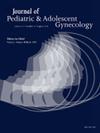43. Fetal cyst and follicular cyst in a neonate girl - treatment tactics
IF 1.8
4区 医学
Q3 OBSTETRICS & GYNECOLOGY
引用次数: 0
Abstract
Background
Ovarian cysts are common in fetuses and neonates and detected in up to 70% of cases on prenatal ultrasound. The size and appearance of cysts help to classify them as simple or complex indicating a physiologic cyst and ovarian torsion or hemorrhage, respectively. This case report presents conservative and operative tactics for the treatment of neonate's ovarian cysts.
Case
A girl was born at 35 weeks of gestation with an abdominal cystic mass measuring 38 mm in diameter detected on ultrasound at 32 weeks. The normal anatomy of other fetal abdominal organs suggested that an ovarian cyst was the most likely diagnosis. Ultrasound was performed every 4 weeks after birth. Two months after birth the USG shows bilateral ovarian cysts – complex at the left, simple at the right. At the age of three months, an abdominal ultrasound showed a right ovarian cyst of 58 × 56 × 62 mm and a left ovarian cystic mass was 44 × 42 × 42 mm with sediment, after that the patient was hospitalized. Operative treatment was chosen. Laparoscopy revealed necrotic antenatal torsion of the right adnexa with a right ovarian cyst and torsion of the left adnexa with a cyst. Adnexas were twisted between themselves twice. Removal of the right adnexa, adhesiolysis, detorsion of the left adnexa, aspiration of the left ovarian cyst, and biopsy of the left ovary were performed. Histological examination of the removed necrotized right ovary showed fragments of connective tissue with dyscirculatory changes, edema, hemorrhages, necrotic changes, foci of calcinosis. The biopsy of cyst revealed a small fragment of ovarian tissue with foci of edema and dystrophic stroma changes, several primordial follicles. The infant was discharged without any complications. Postoperative observation a month later detected a left ovarian cyst 31 × 27 × 35 mm in diameter at the right. Two months after the surgery the ultrasound reveled normal left ovary with follicles at its own place on the left.
Comments
Treatment of neonatal ovarian cysts must be determined according to the size of the ovarian cyst, clinical manifestation, and ultrasonographic findings. Conservative and operative management of ovarian cysts that appear complex on postnatal USG may lead to ovarian loss. Balanced determination of the tactics of managing simple ovarian cysts contributes to the preservation of ovarian tissue.
43. 1例新生女婴胎儿囊肿及卵泡囊肿的治疗策略
背景:卵巢囊肿在胎儿和新生儿中很常见,产前超声检查可检出高达70%的病例。囊肿的大小和外观有助于将其分类为简单或复杂,分别指示生理性囊肿和卵巢扭转或出血。本病例报告提出保守和手术治疗新生儿卵巢囊肿的策略。病例一名女婴在妊娠35周出生,在妊娠32周超声检查中发现腹部直径38毫米的囊性肿块。其他胎儿腹部器官的正常解剖提示卵巢囊肿是最有可能的诊断。产后每4周进行一次超声检查。出生两个月后USG显示双侧卵巢囊肿——左边是复杂的,右边是简单的。3个月大时腹部超声示右侧卵巢囊肿58 × 56 × 62 mm,左侧卵巢囊肿44 × 42 × 42 mm伴沉淀。选择手术治疗。腹腔镜检查显示胎儿坏死的右附件有右卵巢囊肿和左附件有囊肿。附件在它们之间缠绕了两次。行右附件切除、粘连松解、左附件扭曲、左卵巢囊肿抽吸、左卵巢活检。切除的坏死右侧卵巢组织学检查显示结缔组织碎片伴循环障碍改变、水肿、出血、坏死改变、钙质沉着灶。囊肿的活检显示卵巢组织的一小块,水肿灶和营养不良的间质改变,几个原始卵泡。婴儿出院时没有出现任何并发症。术后观察1个月后发现左侧卵巢囊肿31 × 27 × 右侧直径35 mm。手术两个月后,超声检查显示左侧卵巢正常,左侧有卵泡。新生儿卵巢囊肿的治疗必须根据卵巢囊肿的大小、临床表现和超声检查结果来确定。卵巢囊肿出现复杂的产后USG保守和手术管理可能导致卵巢丧失。平衡确定单纯性卵巢囊肿的治疗策略有助于保存卵巢组织。
本文章由计算机程序翻译,如有差异,请以英文原文为准。
求助全文
约1分钟内获得全文
求助全文
来源期刊
CiteScore
3.90
自引率
11.10%
发文量
251
审稿时长
57 days
期刊介绍:
Journal of Pediatric and Adolescent Gynecology includes all aspects of clinical and basic science research in pediatric and adolescent gynecology. The Journal draws on expertise from a variety of disciplines including pediatrics, obstetrics and gynecology, reproduction and gynecology, reproductive and pediatric endocrinology, genetics, and molecular biology.
The Journal of Pediatric and Adolescent Gynecology features original studies, review articles, book and literature reviews, letters to the editor, and communications in brief. It is an essential resource for the libraries of OB/GYN specialists, as well as pediatricians and primary care physicians.

 求助内容:
求助内容: 应助结果提醒方式:
应助结果提醒方式:


